Porsche 959
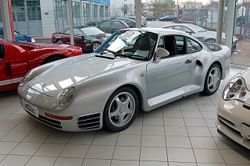 |
|
| Manufacturer | Porsche |
|---|---|
| Production | 1986–1989 (337 produced)[1] |
| Successor | Porsche 911 GT1 |
| Class | Sports car 200 produced |
| Body style(s) | 2-door coupé |
| Layout | Rear-engine, four-wheel drive |
| Engine(s) | 2847 cc turbocharged flat-6 |
| Transmission(s) | 6-speed manual |
| Wheelbase | 2,272 mm (89.4 in) |
| Length | 4,260 mm (168 in) |
| Width | 1,840 mm (72 in) |
| Height | 1,280 mm (50 in) |
| Curb weight | 1,450 kg (3,200 lb) |
| Related | Porsche 911, Porsche 911 Turbo, Porsche 961 |
The Porsche 959 is a sports car manufactured by Porsche from 1986 to 1989, first as a Group B rally car and later as a legal production car designed to satisfy FIA homologation regulations requiring that a minimum number of 200 street legal units be built.[2]
During its production run, it was hailed as being the most technologically advanced road-going sports car ever built and the harbinger of the future of sports cars: it was one of the first high-performance vehicles to use an all-wheel drive system; it provided the basis for Porsche's first all-wheel drive Carrera 4 model; and it convinced Porsche executives of the system's viability so well that they chose to make all-wheel drive standard on all versions of the 911 Turbo starting with the 993 variant. During its lifetime, the vehicle had only one other street legal peer with comparable performance, the Ferrari F40. The 959's short production run and performance have kept values high.
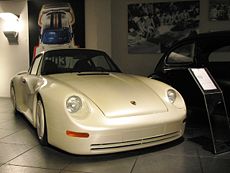
1983 Porsche 959 Concept Car
|
Contents |
History
Development of the 959 (originally called the Gruppe B) started in 1981, shortly after the company's then-new Managing Director, Peter Schutz, took his office. Porsche's head engineer at the time, Helmuth Bott, approached Schutz with some ideas about the Porsche 911, or more aptly, a new one. Bott knew that the company needed a sports car that they could continue to rely on for years to come and that could be developed as time went on. Curious as to how much they could do with the rear-engined 911, Bott convinced Schutz that development tests should take place, and even proposed researching a new all wheel drive system. Schutz agreed, and gave the project green light. Bott also knew through experience that a racing program usually helped to accelerate the development of new models. Seeing Group B rally racing as the perfect arena to test the new mule and its all wheel drive system, Bott again went to Schutz and got the go ahead to develop a car, based on his development mule, for competition in Group B.

Porsche began with an engine they already had, and moved on with development from there. The powerplant, a twin turbocharged boxer six cylinder engine with an air-cooled block and water-cooled heads, displaced 2.85 liters, about half a liter less than a contemporary 911 engine. The motor had originally been developed for the "Moby Dick" race car and then been redeveloped slightly for the short-lived Porsche Indy Car and several other projects before being "tweaked" a last time for use in the 961, the 959's racing counterpart. The water-cooled cylinder heads combined with the air-cooled block, 4-valve heads and sequential turbochargers allowed Porsche to extract 331 kW (444 hp) from the compact, efficient and rugged power unit.[3] The use of sequential twin turbochargers rather than the more usual identical turbochargers for each of the two cylinder banks allowed for smooth seamless delivery of power across the engine RPM band, in contrast to the abrupt on-off power characteristic that distinguished Porsche's turbocharged engines of the period. It has been speculated the engine was capable of over 600 hp (450 kW) if fully tuned. The engine was used, virtually unchanged, in the 959 road car as well.
In an attempt to create a rugged, lightweight shell, Porsche adopted an aluminium and Aramid (Kevlar or Twaron) composite for body use along with a Nomex floor, instead of the steel that was normally used on their production cars[4]. The vehicle's weight of 3,190 pounds (1,450 kg) helped to achieve its high performance level.
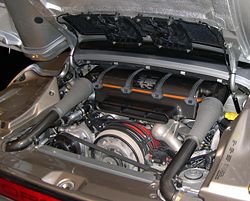
Porsche also developed the car's aerodynamics, which were designed to increase stability, as was the automatic ride height adjustment that became available on the street car (961 race cars had fixed suspensions). Its "zero lift" aerodynamics were a big part of keeping it drivable. The 959 also featured Porsche-Steuer Kupplung (PSK) which was at the time the most advanced all wheel drive system that had been used in a production car. Capable of dynamically changing the torque distribution between the rear and front wheels in both normal conditions and slip conditions, the PSK system allowed the 959 the adaptability it needed both as a race car and as a "super" street car. Under hard acceleration, PSK could send as much as 80% of available power to the rear wheels, helping make the most of the rear-traction bias that occurs during such circumstances[5] It could also vary the power bias depending on road surface and grip changes, helping maintain traction at all times. The magnesium alloy wheels were unique, being hollow inside to form a sealed chamber contiguous with the tire and equipped with a built-in tire pressure monitoring system [6].
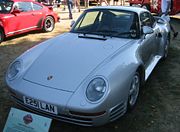
The 1983 Frankfurt Motor Show was chosen for the unveiling of the Porsche Group B prototype. Even in the waning hours of October 9, finishing touches were placed on the car to go on display the next morning. After the first two prototypes, the bodywork was modified to include air vents in the front and rear wheel housings, as well as intake holes behind the doors. The first prototype modified like this was code named "F3", and was destroyed in the first crash test.
The street version of the 959 debuted at the 1985 Frankfurt Motor Show as a 1986 model, but numerous issues delayed production by more than a year. The car was manufactured in two levels of trim, "Sport" and "Komfort", corresponding to the race version and the street version, respectively. First customer deliveries of the 959 street variant began in 1987, and the car debuted at a cost of $225,000 USD per unit, still less than half what it cost Porsche to build each one, production ended in 1988. In total, 337 cars were built, including 37 prototypes and preproduction models[7]. At least one 959 and one 961 remain in the Porsche historic hall in Stuttgart, Germany.
In 1992/1993, Porsche built a highly limited batch of eight 959s assembled from spare parts from the inventory at the manufacturing site in Zuffenhausen[8]. All eight cars were 'Komfort'-versions, four in red and four in silver. These cars were much more expensive (747,500 German Marks) than the ones produced in 1987/1988 (420,000 German Marks). The cars also featured a newly developed speed-sensitive damper system which was not available on the cars from the ordinary production run. The cars were sold to selected collectors after being driven by works personnel for some time[9] and are today by far the most sought-after 959s.
The 959 was not street legal in the United States prior to 1999 when the "Show and Display" law was passed, although an unknown number were imported via the "grey market" during the late 1980s as show pieces. During the model's development, Porsche refused to provide the United States Department of Transportation with the four 959's they required for crash testing, and the car was never certified by the NHTSA for street use in the U.S. With the passage of "Show and Display" the crash test requirements were removed and importation of the 959 was allowed, assuming the car could meet the applicable emissions standards that existed as of 1987. The 959 can be fitted with a catalytic converter and a rechipped computer which allows it to meet those emissions requirements. However, most owners refuse to modify their 959s, and the cars remain collection pieces. Most 959s are currently in the hands of collectors, but the ones that are available do occasionally come to market, with prices in the region of 180,000 - 250,000 EUR (cars produced in 1987/1988). It is impossible to estimate the price of cars from the highly limited batch of 1992/1993.
The lessons learned from the 959 project about engine management, aerodynamics, suspension tuning, and four wheel drive were what enabled the production life of the 911, once thought to be nearing obsolescence due to the extreme rearward placement of the engine, to be extended to the present day.
Performance
'(mph)'
- 0-60: 3.6 s
- 0-100: 8.3 s
- 0-125: 12.7 s
- 0-140: 19.0 s
- 0-1/4 mile (~400 m): 11.8 s @ 119 mph (192 km/h) (standing)
- Top Speed: + 197 mph (317 km/h)
'(km/h)'
- 0-100: 3.7 s
- 0-160: 8.3 s
- 0-200: 12.7 s
- 0-1000 meters: 21.6 s (standing)
Racing
When Porsche began development of the 959, it looked toward Group B racing as a road-racing laboratory with which to develop technology for production cars. When Group B became focused on rallying events, however, Porsche felt the relevance to production cars was greatly reduced, and the goal of the 959 project shifted to frank state-of-the-art, cost-no-object technological innovation.
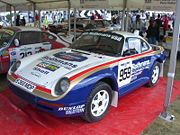
In 1984, however, three 911s modified to 959 specifications (due to the requirement that Group B cars be based on production cars with at least 200 built) were used in the Paris-Dakar Rally, with Jacky Ickx the prime motivator. By 1985 the 959 rally variant was ready, but it experienced a disappointing start: all three cars failed to finish. However, in 1986 the 959 finished 1-2. The 959 was never seriously considered for a Group B Rally season; the cost of completing a full season far outweighed any technical information that would have been gained.
1986 was also the year that the racing variant, the Porsche 961, made its debut at the 24 Hours of Le Mans. Driven by René Metge partnering Claude Ballot-Léna, it finished first in its class and 7th overall. It returned in 1987 but failed to finish after a spin while in 11th place. Thus ended the career of the 961.
Canepa Design modifications
In 2003, Canepa Design initiated a 959 program. By making their own modifications to the 959's turbo, exhaust and computer-control systems, Canepa could enable the 959 to pass emissions requirements (thereby making it street legal in the US) and extract more power from the 959's engine. Total power output from the Canepa-modified 959 is 576 hp (430 kW) and 505 lb·ft (685 N·m) of torque, making the car capable of low 3 second 0-60 times and top speeds in excess of 200 miles per hour (320 km/h). Canepa also modifies the 959's lightweight magnesium wheels, allowing them to be fitted with a modern Michelin high performance tire capable of handling the increased performance.
"Gates 959"
The "Gates 959" is an infamous car,[10] one of 337 Porsche 959s built in the mid-eighties, that was imported by Bill Gates to the US in 1987. Paul Allen imported another one, as did Porsche collector Jerry Seinfeld. These cars had not been approved by regulators and had no United States Department of Transportation and United States Environmental Protection Agency approval. The "Gates 959" was stored for 13 years by the US Customs at the Port of Seattle, until regulations were changed to allow "Autos of Interest" to be imported with severe limitations on their use.[10] Gates and Allen both helped pass the "Show and Display" law.[10][11]
Legacy
By 1991, with the introduction of the 964 generation 911, Porsche had already begun using many of the technologies they had mastered with the 959/961. The 964 became the first 911 available with four wheel drive. However, owing to the complexity and expense of the 959's derived four wheel drive system the successor of the 964, the Porsche 993 Carrera 4, features a far more conventional all-wheel-drive system. Instead of an epicyclic differential and a multi-plate clutch, it used a simple viscous-coupling LSD as a centre differential. Typically, a viscous-coupling in AWD cars results in understeer, but for the rear-wheel-drive-based 911, this meant it remained loyal to the Carrera 2’s character yet provided superior grip when needed. This AWD system is still applied in today's Carrera 4 and Turbo models. The Porsche 993 Turbo was, after the 959, the first 911 variant to combine turbocharging with 4WD. The 993 Turbo also adopted twin-turbochargers, however not in the 959's particular configuration. The 993 and 959 also share a strong physical resemblance in the front end.
In 2004, Sports Car International named this car number one on the list of Top Sports Cars of the 1980s.
In popular culture
- The car shown in the opening sequence of the video game Action Fighter bears a striking resemblance to the Porsche 959.
- The 959 appears in the opening movie of the video game Need for Speed: Porsche Unleashed for Playstation. It was also available for the PC version, but then it first had to be downloaded from the official NFS website. If not, players would find the car in the showroom, covered with a car cover.
- The 1989 Accolade game "The Duel: Test Drive 2" came with 3 cars, the Porsche 959 (Silver), Lamborghini Countach (Black) and a Ferrari F40 (Red).
References
- Bowler, M & Wood, J (1997). The Fastest Cars From Around the World. Parragon. ISBN 0-7525-1022-3.
- Frère, P (1999). Porsche 911 Story (sixth edition). Patrick Stevens Limited. ISBN 1-85260-590-1
- Wood, J (1997). Porsche: The Legend. Parragon. ISBN 0-7525-2072-5.
- MPH magazine Greatest Cars Ever: Porsche 959
Notes
- ↑ Ludvigsen, Karl (2003). Porsche. Excellence Was Expected, vol.3. Cambridge, Mass.: Bentley Publishers. pp. 1032. ISBN 0-8376-0235-1.
- ↑ Ludvigsen, Karl (2003). Porsche. Excellence Was Expected, vol.3. Cambridge, Mass.: Bentley Publishers. pp. 1003. ISBN 0-8376-0235-1.
- ↑ Porsche.com: "1987/88 Porsche 959"
- ↑ Ludvigsen, Karl (2003). Porsche. Excellence Was Expected, vol.3. Cambridge, Mass.: Bentley Publishers. pp. 1009. ISBN 0-8376-0235-1.
- ↑ Ludvigsen, Karl (2003). Porsche. Excellence Was Expected, vol.3. Cambridge, Mass.: Bentley Publishers. pp. 1012. ISBN 0-8376-0235-1..
- ↑ Ludvigsen, Karl (2003). Porsche. Excellence Was Expected, vol.3. Cambridge, Mass.: Bentley Publishers. pp. 1011. ISBN 0-8376-0235-1.
- ↑ Ludvigsen, Karl (2003). Porsche. Excellence Was Expected, vol.3. Cambridge, Mass.: Bentley Publishers. pp. 1032. ISBN 0-8376-0235-1.
- ↑ Ludvigsen, Karl (2003). Porsche. Excellence Was Expected, vol.3. Cambridge, Mass.: Bentley Publishers. pp. 1032. ISBN 0-8376-0235-1.
- ↑ Ludvigsen, Karl (2003). Porsche. Excellence Was Expected, vol.3. Cambridge, Mass.: Bentley Publishers. pp. 1032. ISBN 0-8376-0235-1.
- ↑ 10.0 10.1 10.2 Stephan Wilkinson. The Gold-Plated Porsche. The Lyons Press, Guilford, Connecticut (2005) pages 21-2, ISBN=1-59228-792-1.
- ↑ How To Import A Motor Vehicle For Show Or Display
External links
- 1986 959 at official Porsche website
- 1986 959 Paris-Dakar at official Porsche website
- 1987/1988 959 at official Porsche website
| Preceded by Ferrari 288 GTO |
Fastest street-legal production car 317 km/h (197 mph) |
Succeeded by Ferrari F40 |
| Dr. Ing. h.c. F. Porsche AG road car timeline, 1960–present | ||||||||||||||||||||||||||||||||||||||||||||||||||
|---|---|---|---|---|---|---|---|---|---|---|---|---|---|---|---|---|---|---|---|---|---|---|---|---|---|---|---|---|---|---|---|---|---|---|---|---|---|---|---|---|---|---|---|---|---|---|---|---|---|---|
| Type | 1960s | 1970s | 1980s | 1990s | 2000s | |||||||||||||||||||||||||||||||||||||||||||||
| 0 | 1 | 2 | 3 | 4 | 5 | 6 | 7 | 8 | 9 | 0 | 1 | 2 | 3 | 4 | 5 | 6 | 7 | 8 | 9 | 0 | 1 | 2 | 3 | 4 | 5 | 6 | 7 | 8 | 9 | 0 | 1 | 2 | 3 | 4 | 5 | 6 | 7 | 8 | 9 | 0 | 1 | 2 | 3 | 4 | 5 | 6 | 7 | 8 | 9 | |
| Entry Level Sportscar | 912 | 924 | Boxster (986) | Boxster (987) | ||||||||||||||||||||||||||||||||||||||||||||||
| 356 | 914 | 944 | 968 | Cayman | ||||||||||||||||||||||||||||||||||||||||||||||
| 911 Series | 911 | 911 / 930 | 911 (964) | 911 (993) | 911 (996) | 911 (997) | ||||||||||||||||||||||||||||||||||||||||||||
| GT | 928 | |||||||||||||||||||||||||||||||||||||||||||||||||
| Sedan | Panamera | |||||||||||||||||||||||||||||||||||||||||||||||||
| Supercar | 959 | 911 GT1 | Carrera GT | |||||||||||||||||||||||||||||||||||||||||||||||
| SUV | Cayenne | |||||||||||||||||||||||||||||||||||||||||||||||||
| Concept cars | 356/1 · 114 · 695 · 901 · 989 · Panamericana · Panamera · Roxster | |||||||||||||||||||||||||||||||||||||||||||||||||
| Motorsport | Porsche in motorsport · Porsche Junioren · Porsche Supercup · 64 · 360 · 550 · 718 · 787 · 804 · 904 · 906 · 907 · 908 · 909 · 910 · 914-6 GT · 917 · 934 · 935 · 936 · 953 · 956 · 961 · 962 · GT1 · GT2 · GT3 · WSC-95 · LMP · RS Spyder | |||||||||||||||||||||||||||||||||||||||||||||||||
| People | Ferdinand Porsche · Ferry Porsche · Ferdinand Alexander Porsche · Ferdinand Piëch · Wendelin Wiedeking | |||||||||||||||||||||||||||||||||||||||||||||||||
| Tractors | Junior · Super | |||||||||||||||||||||||||||||||||||||||||||||||||
| Other | Official Website · Porsche Design Group · Volkswagen Group · List of Porsche engines · Tiptronic · VarioCam | |||||||||||||||||||||||||||||||||||||||||||||||||